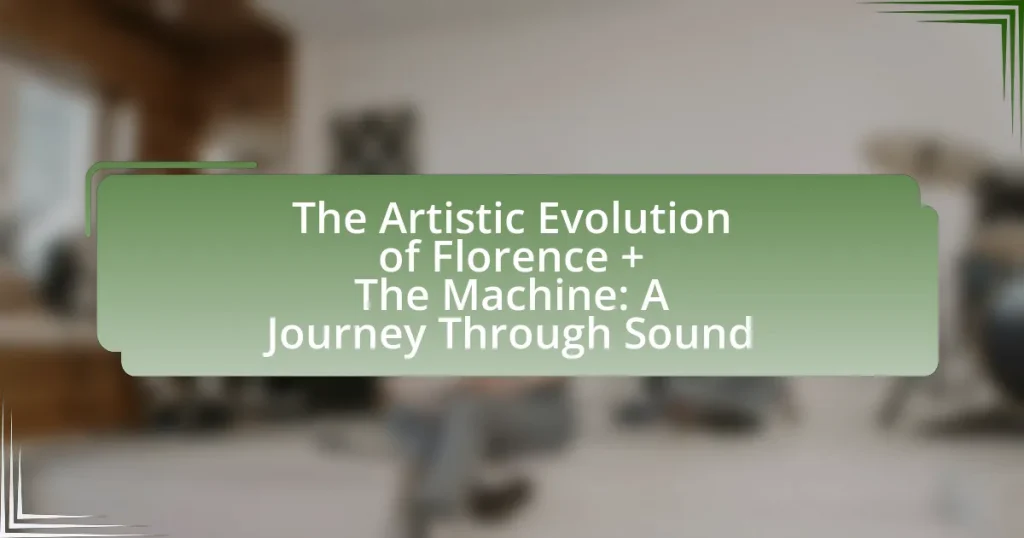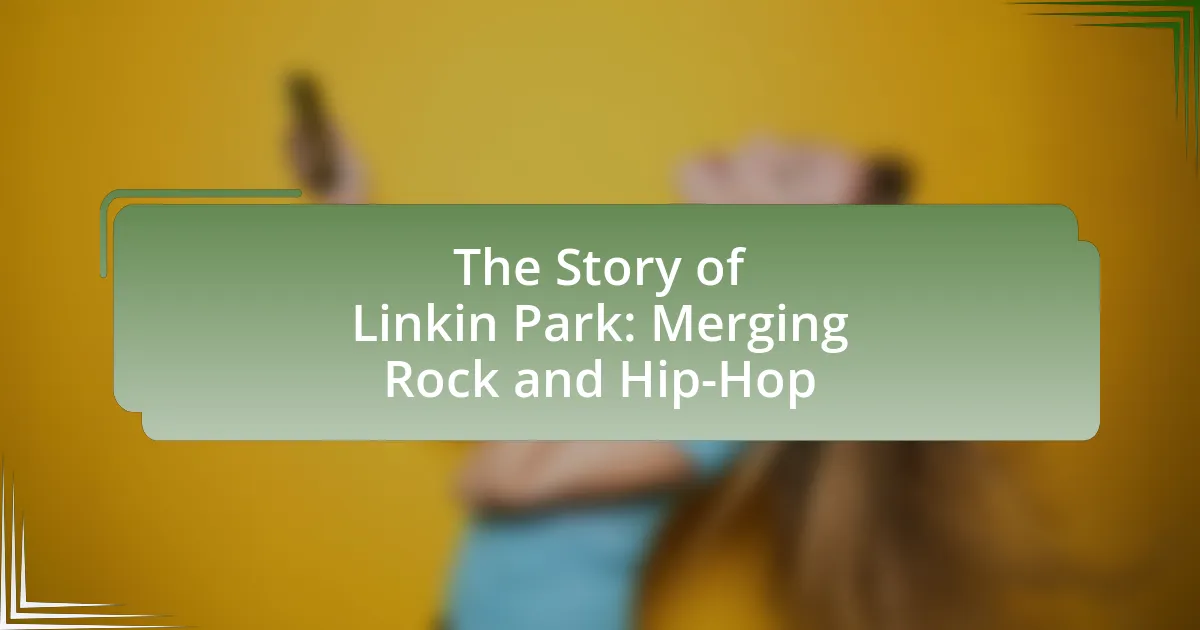Florence + The Machine is a British band known for their artistic evolution from baroque pop and indie rock to a more eclectic sound that incorporates soul, electronic, and world music. The article explores their musical journey, highlighting key albums such as “Lungs,” “Ceremonials,” and “How Big, How Blue, How Beautiful,” which showcase their growth in complexity and lyrical depth. It also examines the band’s formation, early influences, and the impact of live performances on their artistic expression, as well as the critical reception and cultural significance of their work. Additionally, the article discusses the evolution of their sound, instrumentation, and lyrical themes, providing insights into their future projects and collaborations.

What is the Artistic Evolution of Florence + The Machine?
The artistic evolution of Florence + The Machine is characterized by a progression from baroque pop and indie rock to a more eclectic sound that incorporates elements of soul, electronic, and world music. Initially, their debut album “Lungs” (2009) showcased a dramatic and emotive style, featuring powerful vocals and rich instrumentation, which earned them critical acclaim and commercial success. As they moved into their subsequent albums, such as “Ceremonials” (2011) and “How Big, How Blue, How Beautiful” (2015), the band expanded their musical palette, integrating more diverse influences and experimenting with production techniques. This evolution is evident in tracks like “Shake It Out” and “Ship to Wreck,” where the blend of genres and lyrical depth reflects a maturation in their artistry. The latest album, “Dance Fever” (2022), further illustrates this evolution by embracing a more dance-oriented sound while maintaining the emotive storytelling that defines their work.
How did Florence + The Machine begin their musical journey?
Florence + The Machine began their musical journey when Florence Welch, the lead vocalist, started performing in London clubs in the mid-2000s. She collaborated with musician Isabella Summers, who became a key member of the band, and together they created a unique sound that blended baroque pop and soul influences. Their first significant breakthrough came with the release of the single “Kiss with a Fist” in 2008, which garnered attention and led to the release of their debut album, “Lungs,” later that year. “Lungs” achieved critical and commercial success, solidifying their place in the music industry and showcasing their distinctive style.
What were the early influences on Florence Welch’s music?
Florence Welch’s music was early influenced by a diverse range of artists and genres, particularly the works of Kate Bush, Björk, and the gothic rock band Siouxsie and the Banshees. These influences shaped her distinctive sound, characterized by dramatic vocals and emotive lyrics. Welch has cited Kate Bush’s theatrical style and Björk’s experimental approach as pivotal in her artistic development, while the dark, atmospheric elements of Siouxsie and the Banshees contributed to her unique aesthetic. This blend of influences is evident in the ethereal and powerful nature of her music, which has garnered critical acclaim and a dedicated fanbase.
How did the band’s formation contribute to their sound?
The band’s formation significantly contributed to their sound by blending diverse musical influences and backgrounds. Florence Welch, the lead vocalist, brought a theatrical and emotive style, while the instrumentalists, including guitarist Rob Ackroyd and keyboardist Isabella Summers, infused elements of rock, baroque pop, and soul. This eclectic mix created a rich, layered sound characterized by powerful vocals and dynamic instrumentation. The collaborative nature of their formation allowed for experimentation, leading to unique arrangements and a distinctive sonic identity that has evolved over time, as evidenced by their critically acclaimed albums like “Lungs” and “Ceremonials.”
What are the key albums that define their artistic evolution?
The key albums that define the artistic evolution of Florence + The Machine are “Lungs,” “Ceremonials,” and “How Big, How Blue, How Beautiful.” “Lungs,” released in 2009, introduced their unique sound, blending baroque pop and soul, and featured hits like “Dog Days Are Over.” “Ceremonials,” released in 2011, expanded their sound with grander production and themes of love and loss, highlighted by tracks such as “Shake It Out.” “How Big, How Blue, How Beautiful,” released in 2015, marked a shift towards a more personal and introspective style, showcasing a mature sound with songs like “What Kind of Man.” Each album reflects significant growth in musical complexity and lyrical depth, illustrating their artistic journey.
How did ‘Lungs’ shape the band’s identity?
‘Lungs’ significantly shaped Florence + The Machine’s identity by establishing their unique sound characterized by a blend of baroque pop and soul influences. The album’s commercial success, debuting at number one on the UK Albums Chart and selling over three million copies in the US, solidified the band’s presence in the music industry. Additionally, the thematic depth of ‘Lungs,’ exploring love, loss, and existentialism, resonated with a wide audience, further defining the band’s artistic persona. The lead single “Dog Days Are Over” became an anthem, showcasing Florence Welch’s powerful vocals and emotive lyricism, which became hallmarks of the band’s identity.
What themes are explored in ‘Ceremonials’?
The themes explored in ‘Ceremonials’ by Florence + The Machine include love, loss, spirituality, and the interplay between life and death. The album delves into the emotional complexities of relationships, often portraying love as both uplifting and painful. Spirituality is a recurring motif, with references to rituals and transcendence, reflecting a quest for meaning. Additionally, the juxtaposition of life and death is evident, as the lyrics navigate the tension between joy and sorrow, ultimately celebrating the beauty found within these contrasts. This thematic richness is supported by the album’s orchestral arrangements and lyrical depth, which enhance the exploration of these profound subjects.
How did ‘How Big, How Blue, How Beautiful’ mark a turning point?
‘How Big, How Blue, How Beautiful’ marked a turning point for Florence + The Machine by showcasing a significant shift in their musical style and lyrical depth. This album, released in 2015, introduced a more mature sound characterized by orchestral arrangements and introspective themes, reflecting personal struggles and emotional growth. The lead single, “What Kind of Man,” exemplified this evolution with its powerful instrumentation and raw vulnerability, indicating a departure from the more whimsical elements of their earlier work. Additionally, the album received critical acclaim, debuting at number one on the UK Albums Chart and solidifying the band’s status as a leading force in contemporary music.
What musical styles and genres have influenced their sound?
Florence + The Machine’s sound has been influenced by a diverse range of musical styles and genres, including baroque pop, soul, and indie rock. The incorporation of baroque pop is evident in their use of orchestral arrangements and dramatic melodies, while soul influences are reflected in Florence Welch’s powerful vocal delivery and emotional depth. Additionally, indie rock elements contribute to their unique sound through the use of unconventional song structures and instrumentation. These influences combine to create a rich, layered musical experience that defines the band’s artistic identity.
How does baroque pop manifest in their music?
Baroque pop manifests in Florence + The Machine’s music through the incorporation of orchestral arrangements, complex harmonies, and dramatic instrumentation. This genre blends traditional pop elements with classical music influences, evident in songs like “Shake It Out,” where lush strings and choral backing elevate the emotional intensity. The use of varied dynamics and rich textures, characteristic of baroque music, enhances the theatricality of their sound, creating a grand and immersive listening experience.
What role does indie rock play in their artistic expression?
Indie rock serves as a foundational element in the artistic expression of Florence + The Machine, allowing for a unique blend of genres and personal storytelling. This genre provides the band with the freedom to experiment with diverse sounds, instrumentation, and lyrical themes, which is evident in their albums that often incorporate elements of baroque pop, soul, and folk. The band’s use of indie rock aesthetics enables them to maintain authenticity and emotional depth, as seen in tracks like “Shake It Out” and “Dog Days Are Over,” where introspective lyrics are paired with expansive soundscapes. This artistic approach has contributed to their critical acclaim and commercial success, highlighting the significant role indie rock plays in shaping their musical identity.
How has the band’s sound evolved over time?
Florence + The Machine’s sound has evolved from a baroque pop and indie rock style in their debut album “Lungs” to a more eclectic mix of genres, including soul, electronic, and art rock in subsequent works. The transition is evident in their second album, “Ceremonials,” which featured grand orchestration and a more polished production, showcasing a shift towards a more anthemic sound. By the time of their third album, “How Big, How Blue, How Beautiful,” the band incorporated a more personal and introspective lyrical approach, blending rock with elements of folk and pop. This evolution continued with “High as Hope,” where the sound became more stripped down and intimate, reflecting a maturation in both musical style and lyrical content. Each album marks a distinct phase in their artistic journey, demonstrating their ability to adapt and innovate while maintaining a signature emotional depth.
What changes in instrumentation have occurred throughout their albums?
Throughout their albums, Florence + The Machine have evolved their instrumentation from a primarily baroque pop sound to a more eclectic mix incorporating electronic elements and diverse musical styles. In their debut album, “Lungs,” the instrumentation featured orchestral arrangements, including strings and piano, which created a rich, dramatic sound. As they progressed to “Ceremonials,” the band expanded their use of percussion and layered harmonies, enhancing the anthemic quality of their music. By the time they reached “How Big, How Blue, How Beautiful,” they incorporated more rock influences, utilizing electric guitars and a more stripped-down production approach. This evolution continued with “High as Hope,” where the instrumentation became more intimate, focusing on piano and subtle arrangements, reflecting a shift towards personal storytelling. Each album showcases a deliberate change in instrumentation that mirrors their artistic growth and exploration of new musical landscapes.
How have orchestral elements been integrated into their music?
Orchestral elements have been integrated into Florence + The Machine’s music through the use of lush string arrangements, brass sections, and choral backing that enhance the emotional depth of their sound. For instance, the album “Ceremonials” prominently features orchestral strings and choirs, creating a grand, cinematic atmosphere that complements Florence Welch’s powerful vocals. This integration is evident in tracks like “Shake It Out,” where the orchestral build-up intensifies the song’s themes of liberation and renewal, showcasing how these elements contribute to the overall narrative and emotional impact of their music.
What impact do electronic influences have on their recent work?
Electronic influences have significantly transformed the recent work of Florence + The Machine by integrating synthesized sounds and digital production techniques. This shift has allowed the band to explore new sonic landscapes, blending traditional instrumentation with electronic elements, which enhances their musical versatility. For instance, the album “High as Hope” features tracks that utilize electronic beats and ambient textures, showcasing a departure from their earlier, more organic sound. This evolution reflects broader trends in contemporary music, where artists increasingly incorporate electronic influences to create innovative and immersive listening experiences.
How have lyrical themes evolved in their discography?
Lyrical themes in Florence + The Machine’s discography have evolved from early explorations of love and heartbreak to more complex themes of empowerment, existentialism, and personal growth. Initially, songs like “Dog Days Are Over” and “Shake It Out” focused on emotional turmoil and the struggles of relationships, reflecting a sense of vulnerability. As their work progressed, particularly in albums like “How Big, How Blue, How Beautiful” and “High as Hope,” the lyrics began to incorporate broader themes of self-acceptance, resilience, and societal issues, showcasing a maturation in both lyrical content and perspective. This evolution is evident in tracks such as “Hunger,” which addresses the search for identity and fulfillment, indicating a shift towards introspection and social commentary.
What personal experiences does Florence Welch draw from in her lyrics?
Florence Welch draws from her personal experiences with love, heartbreak, and mental health in her lyrics. These themes are often reflective of her own struggles, such as her battles with anxiety and the emotional turmoil stemming from relationships. For instance, her song “Shake It Out” addresses the process of letting go of past regrets and pain, illustrating her journey toward healing. Additionally, her experiences with loss and the complexities of identity are evident in tracks like “What Kind of Man,” where she explores the dynamics of love and self-worth.
How do their lyrics reflect broader societal issues?
The lyrics of Florence + The Machine reflect broader societal issues by addressing themes such as mental health, gender inequality, and the struggle for personal identity. For instance, the song “Shake It Out” tackles the burden of past traumas and societal expectations, illustrating the pressure individuals face to conform. Additionally, “What Kind of Man” critiques toxic masculinity and the complexities of romantic relationships, highlighting the impact of gender dynamics on personal experiences. These themes resonate with listeners, as they mirror real-world challenges, making the band’s work relevant to contemporary societal discussions.
What role does live performance play in their artistic evolution?
Live performance plays a crucial role in the artistic evolution of Florence + The Machine by allowing the band to connect deeply with their audience and refine their sound. Through live shows, Florence Welch and her band members experiment with arrangements, vocal delivery, and stage presence, which contributes to their growth as artists. For instance, the band’s early performances showcased a raw, emotive style that has since evolved into a more polished and theatrical presentation, reflecting their artistic maturation. This evolution is evidenced by their increasing use of elaborate stage designs and choreography, which enhances the overall experience and showcases their artistic vision.
How has the band’s stage presence changed over the years?
The band’s stage presence has evolved significantly over the years, transitioning from a more subdued and intimate performance style to a dynamic and theatrical experience. Initially, Florence + The Machine showcased a raw and emotional connection with the audience, often characterized by minimalistic staging and a focus on vocal delivery. As their career progressed, the band incorporated elaborate visual elements, including intricate lighting designs, choreographed movements, and elaborate costumes, enhancing the overall spectacle of their live shows. This transformation is evident in performances from their early tours compared to their later concerts, where the integration of multimedia and stagecraft has created a more immersive experience for fans.
What impact do visual elements have on their live shows?
Visual elements significantly enhance the live shows of Florence + The Machine by creating an immersive experience that captivates the audience. The integration of elaborate stage designs, dynamic lighting, and striking visual effects complements the emotional intensity of their music, fostering a deeper connection between the performers and the audience. For instance, during performances of songs like “Shake It Out,” the use of dramatic lighting and ethereal backdrops amplifies the song’s themes of liberation and catharsis, making the experience more memorable. This synergy between music and visuals has been shown to increase audience engagement and emotional response, as evidenced by studies indicating that visual stimuli can enhance the perception of live performances.

What are the critical receptions and cultural impacts of their work?
Florence + The Machine has received widespread critical acclaim for their innovative sound and emotive performances, significantly impacting contemporary music and culture. Their debut album, “Lungs,” released in 2009, was praised for its unique blend of baroque pop and soul, earning a Grammy Award for Best New Artist and topping charts globally. The band’s theatrical style and Florence Welch’s powerful vocals have influenced a generation of artists, contributing to the resurgence of indie and alternative music in mainstream culture. Additionally, their music often explores themes of love, loss, and empowerment, resonating deeply with audiences and fostering a dedicated fanbase. The cultural impact is evident in their collaborations with various artists and their presence in popular media, solidifying their status as a defining act of the 21st century.
How have critics responded to their albums over time?
Critics have responded to Florence + The Machine’s albums with a mix of acclaim and critique, reflecting their artistic evolution. For instance, their debut album “Lungs” received widespread praise for its originality and vocal power, earning a Grammy Award for Best New Artist in 2010. Subsequent albums, such as “Ceremonials,” were similarly well-received, with critics highlighting the grandiose sound and lyrical depth, leading to nominations for multiple awards. However, some reviews of “How Big, How Blue, How Beautiful” noted a shift towards a more subdued sound, which elicited mixed reactions, though it still achieved commercial success. Overall, the critical reception has generally been positive, with each album showcasing a distinct phase in the band’s artistic journey.
What awards and recognitions have they received?
Florence + The Machine has received numerous awards and recognitions, including the Brit Award for Best British Album in 2010 for “Lungs” and the MTV Europe Music Award for Best UK and Ireland Act in 2010. Additionally, they won the NME Award for Best Solo Artist in 2012 and have been nominated for Grammy Awards, including Best New Artist and Best Pop Vocal Album. These accolades highlight the band’s significant impact on the music industry and their artistic contributions.
How do critics interpret the evolution of their sound?
Critics interpret the evolution of Florence + The Machine’s sound as a dynamic transition from baroque pop to a more eclectic mix of genres, including indie rock and electronic influences. This shift is often highlighted in reviews that note the band’s ability to blend powerful vocals with diverse instrumentation, reflecting a maturation in their artistic expression. For instance, the album “High as Hope” showcases a more introspective and stripped-down approach compared to earlier works, which were characterized by grand orchestration and theatricality. Critics have pointed out that this evolution signifies not only a change in musical style but also a deeper exploration of personal themes, as seen in the lyrical content that addresses vulnerability and self-discovery.
What influence has Florence + The Machine had on contemporary music?
Florence + The Machine has significantly influenced contemporary music by blending baroque pop with indie rock, creating a unique sound characterized by powerful vocals and dramatic instrumentation. Their 2009 debut album, “Lungs,” showcased this style and achieved critical acclaim, earning the Grammy Award for Best New Artist. The band’s theatrical performances and emotive lyrics have inspired a wave of artists across genres, encouraging a focus on authenticity and emotional depth in songwriting. Additionally, their incorporation of diverse musical elements, such as folk and soul, has expanded the sonic palette of modern pop music, influencing artists like Hozier and Bat for Lashes.
How have they inspired other artists in the industry?
Florence + The Machine has inspired other artists in the industry through their unique blend of baroque pop and soul, characterized by powerful vocals and emotive lyrics. This distinctive sound has influenced a range of musicians, encouraging them to explore more theatrical and emotionally resonant styles in their own work. For instance, artists like Hozier and Bat for Lashes have cited Florence Welch’s dynamic stage presence and lyrical depth as significant influences on their music. Additionally, the band’s innovative approach to music videos and live performances has set a standard for visual storytelling in the industry, prompting other artists to prioritize artistic expression in their presentations.
What trends in music can be traced back to their style?
Florence + The Machine’s style has significantly influenced trends in indie rock and baroque pop. Their fusion of ethereal vocals, dramatic instrumentation, and poetic lyrics has inspired a wave of artists seeking to blend emotional depth with eclectic sounds. For instance, the band’s use of orchestral elements and rich harmonies can be traced in the works of contemporary artists like Bat for Lashes and Hozier, who similarly incorporate lush arrangements and introspective themes in their music. This stylistic approach has contributed to the broader trend of genre-blending in modern music, where traditional boundaries between pop, rock, and folk are increasingly blurred.
What can fans expect from Florence + The Machine in the future?
Fans can expect Florence + The Machine to continue evolving their sound while maintaining their signature blend of baroque pop and indie rock. The band has consistently pushed creative boundaries, as evidenced by their diverse discography, which includes the critically acclaimed albums “Lungs,” “Ceremonials,” and “High as Hope.” Future projects are likely to explore new musical styles and themes, reflecting Florence Welch’s artistic growth and personal experiences. This trajectory suggests that fans will encounter innovative sounds and deeper lyrical content in upcoming releases.
How might their sound continue to evolve?
Florence + The Machine’s sound may continue to evolve by incorporating diverse musical influences and experimenting with new production techniques. As seen in their previous albums, such as “High as Hope,” the band has embraced a more introspective and minimalist approach, suggesting a potential shift towards even more nuanced and varied soundscapes. Additionally, collaborations with different artists and producers could introduce fresh elements, further expanding their sonic palette. Historical trends in music indicate that artists who adapt to changing genres and incorporate innovative styles often experience growth and renewed relevance in the industry.
What upcoming projects or collaborations are anticipated?
Florence + The Machine is anticipated to release a new album in 2024, which will mark their first studio project since “High as Hope” in 2018. Additionally, collaborations with various artists are expected, as Florence Welch has expressed interest in working with contemporary musicians to explore new sounds and styles. This aligns with her previous collaborations, such as those with Calvin Harris and Josh Homme, which have expanded her musical range and audience reach.
What are some tips for new listeners to appreciate Florence + The Machine?
To appreciate Florence + The Machine, new listeners should immerse themselves in the emotional depth of the lyrics and the powerful vocal delivery of Florence Welch. Engaging with the themes of love, loss, and empowerment found in songs like “Shake It Out” and “Dog Days Are Over” enhances the listening experience. Additionally, exploring the diverse instrumentation, which blends elements of rock, baroque pop, and soul, allows listeners to appreciate the band’s unique sound. The band’s live performances, known for their theatricality and energy, further exemplify their artistic evolution, making it beneficial for new listeners to watch concert footage or attend a show to fully grasp the impact of their music.
How can listeners explore their discography effectively?
Listeners can explore their discography effectively by utilizing streaming platforms that offer comprehensive catalogs of their music, including albums, singles, and collaborations. These platforms often provide features such as curated playlists, song recommendations based on listening habits, and access to live performances, which enhance the discovery process. Additionally, engaging with official social media channels and websites allows listeners to gain insights into the artistic context of each release, including background stories and thematic elements. This multifaceted approach not only facilitates a deeper understanding of the music but also highlights the evolution of Florence + The Machine’s sound over time.
What live performances should fans seek out for the best experience?
Fans should seek out Florence + The Machine’s festival performances, particularly at events like Glastonbury and Coachella, for the best experience. These performances showcase the band’s dynamic stage presence and elaborate visual elements, creating an immersive atmosphere that enhances the emotional depth of their music. For instance, Florence Welch’s powerful vocals and the band’s energetic instrumentation are often highlighted in these settings, drawing large crowds and receiving critical acclaim. The 2015 Glastonbury performance, which featured a mix of their greatest hits and theatrical staging, is frequently cited as a standout moment in their live history, demonstrating the unique experience fans can expect at such events.


